Sunflower sprouts and sunflower microgreens are an easy to grow and underutilized salad green that is fun to grow at home. You can grow a crop from seed to harvest in as little as 7 to 12 days. There is no need to add additional soil amendments when growing microgreens. The nutrients required by the sprout are already resident in the seed itself.
Sunflower sprouts or sunflower microgreens are easy and nutritious to grow year round. In the summer you can grow them directly in the garden and have a crop every 2 weeks. In the winter you can sprout them indoors under grow lights or even in a sunny window. Unlike other greens like lettuce, sunflower microgreens don’t require strong light to grow well. And instead of waiting 30 to 45 days from sowing to harvest, sunflower sprouts can be ready to harvest in a mere 10 to 14 days from planting. Doesn’t that sound miraculous?
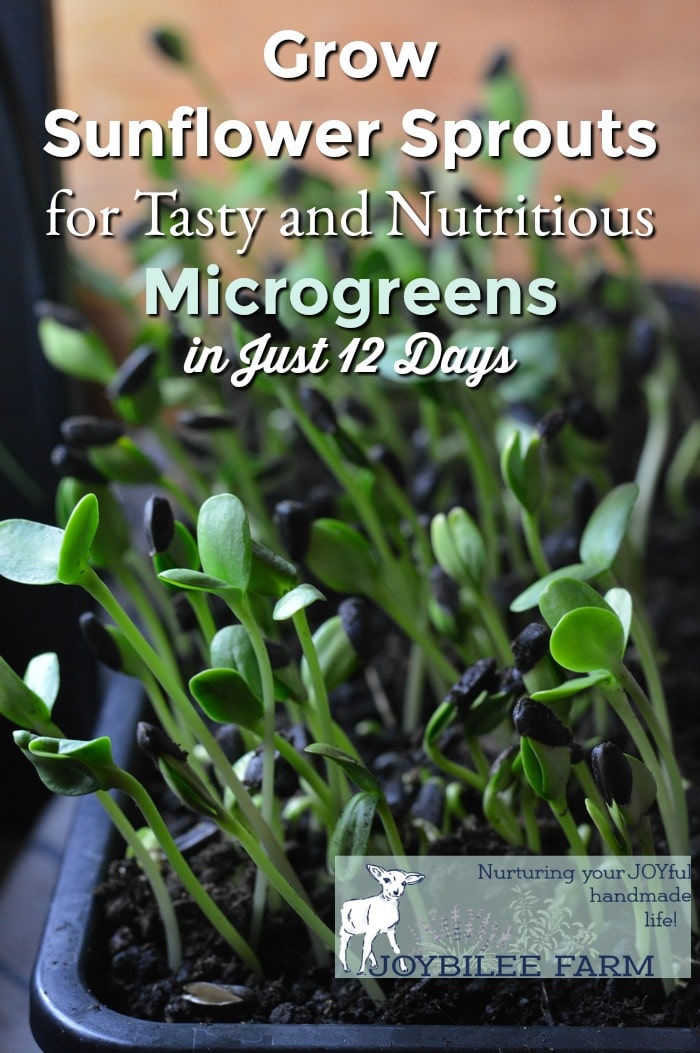
What kind of sunflower seeds do I need for sunflower sprouts?
Black oil sunflowers, the kind sold for birdseed, are the best kind of sunflowers to get for sprouting. You can buy them at the garden store or a specialty microgreen seed supplier in small ¼ to 1 pound packages. However, the least expensive way to purchase them is as organic bird seed or organic animal feed. Feed stores and wild bird stores often carry black oil sunflower seeds in 5 pound, 25 pound, and 50-pound bags.
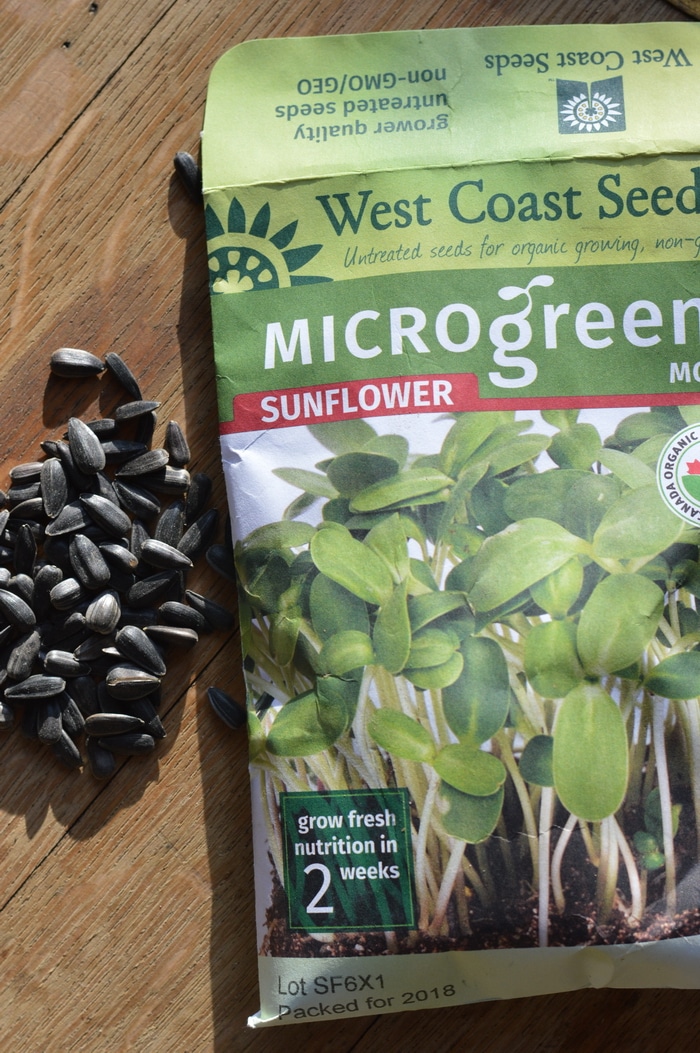
Please do source organic sunflower seed though. The non-organic seed is treated with chemicals to help it dry down evenly, to make it easier to process with farm equipment. You want to avoid those chemicals in your sprouts or microgreens.
If you are growing your own sunflowers for seed, you can use any of the giant sunflowers – black oil or striped varieties are both fine for sunflower sprouts or sunflower microgreens.
Don’t use the striped sunflower seeds that are sold in snack packs of “Spits” though. These have been boiled in salt water and then dried and are no longer raw. They won’t sprout.
1 ounce of sunflower seeds will grow 2 ounces of sunflower sprouts or sunflower microgreens. The root and the seed shell become by-products. Only the stem and green leaves are eaten. Here’s some recipe ideas for using your microgreens.
How much to plant
Each seed will become a single sunflower sprout. You can only harvest each sprout once. They will not regrow after you trim off the leaves from the stem.

Here’s the proportion of sunflower seeds to prepare for different size pots:
- 2 tablespoons of seed (15 grams) covers 25 square inches of pot surface space or a pot that is about 3 ¼ inches wide by 8 inches long.
- 1/4 cup of seed for 100 square inches of pot surface space
- 1/2 cup of seed (2 ounces) for 200 square inches of pot surface or garden bed surface space
What kind of soil should you plant sunflower sprouts in?
While sunflower sprouts can be grown in soilless planting mediums sold for potting mixes, or even on a piece of felt or flannel, I think they grow faster when you add just a bit of fertility, like worm castings, or kelp meal. I cup of worm castings or ¼ cup of kelp meal per 4 cups of potting mix seems to give a good result.
If you are growing them outside in a garden bed, the average fertility of the garden bed is probably sufficient. Sunflower sprouts don’t require much fertility when grown in garden soil.
How to grow sunflower sprouts
Step 1
Sunflower seeds should be soaked for 12 hours or overnight.
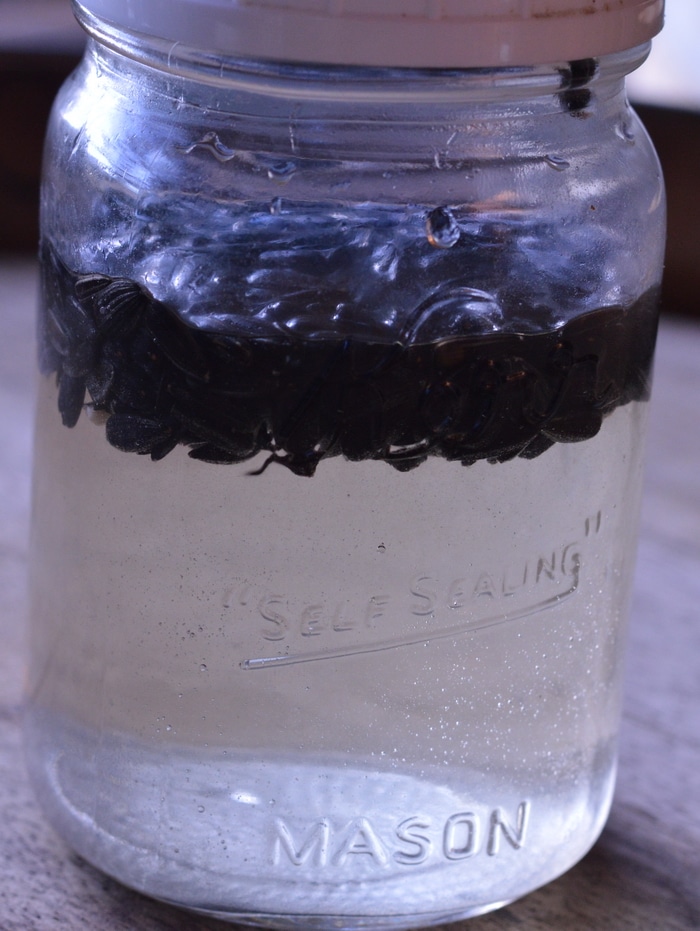
I place them in a mason jar with a tight fitting lid. Fill the jar to the top with water. The sunflower seeds will float initially so it’s important that the lid is secure and the jar is filled to the top with water. Over the next 8 to 12 hours the majority of the seed will absorb water, and sink to the bottom of the jar. Drain the sunflower seeds after 12 hours and replace the lid on the jar with a sprouting lid like this one.
Step 2
Rinse the sunflower seeds 3 to 4 times, 8 to 12 hours apart until you see roots coming out of the seed. This will take 2 or 3 days depending on your ambient temperatures. Drain the sunflower sprouts. Remove them from the jar.
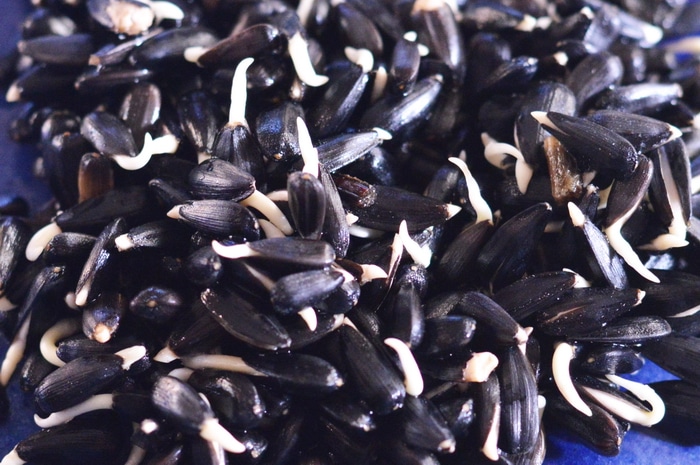
Step 3
Plant the sunflower sprouts in a soilless mix or planting medium in a well-drained container. Cover the sprouted seed with planting medium.
Step 4:
Mist them twice a day. I add 5 drops of lavender essential oil per 2 cups of spring water, to the misting water to help inhibit damping off disease.
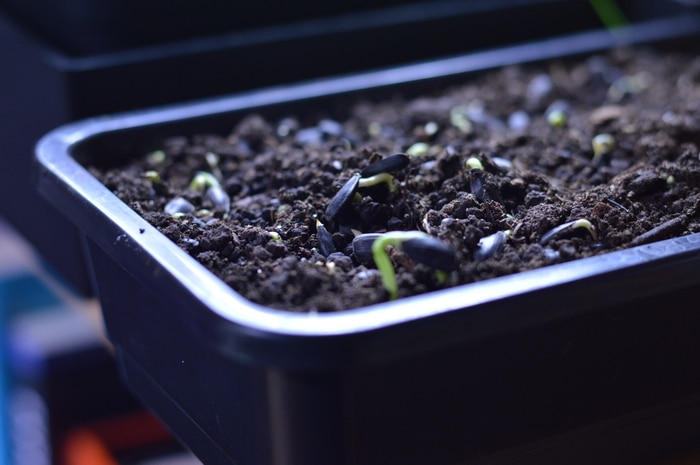
5 days after you first soak them, you should see sprouts coming up through the soil surface with the seed attached to the seed leaves. The sprouts will begin to show rapid growth.
The seed will stay attached until the sunflower sprouts or microgreens shed the seed naturally, as the seed leaves unfurl.
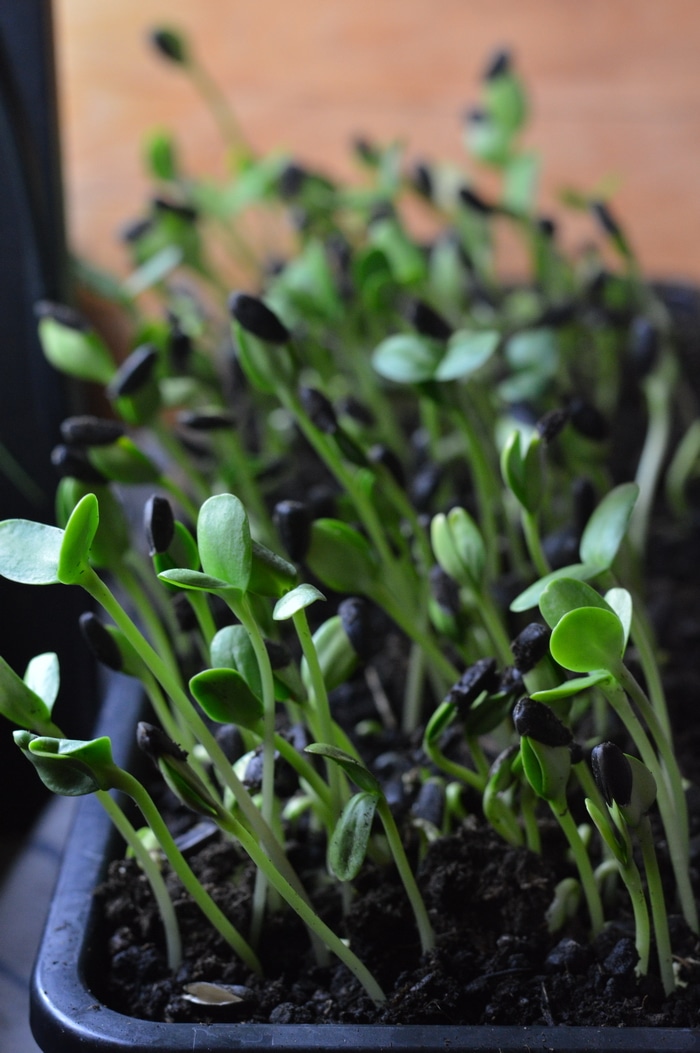
Once the leaves unfurl, around day 10, and the seed shell is dropped your sunflower sprouts become sunflower microgreens. You can harvest them now or wait for the seed leaves to get a little greener and a little plumper.
Step 5:
At this point move the sunflower microgreens to a sunny window. This will keep the stalks shorter. But if you don’t have a sunny window they can be grown under a grow light. The sunflower microgreens require light to turn green. Continue to mist them with water twice a day or more often if you live where the air is dry. As you mist them brush a clean hand gently over the tops to dislodge the shell casings. They will drop off.
Step 6:
Once the sunflower sprouts have shed their black seed case it’s time to start tasting them. You can harvest them any time after the seed case has dropped from day 5 to 12. I like to harvest them when the tiny bud of true leaves is just beginning to show at the crown of the stem. This is when they are the sweetest. As the true leaves develop they get a bit more bitter. Taste them at this stage and harvest them when they taste the best to you.
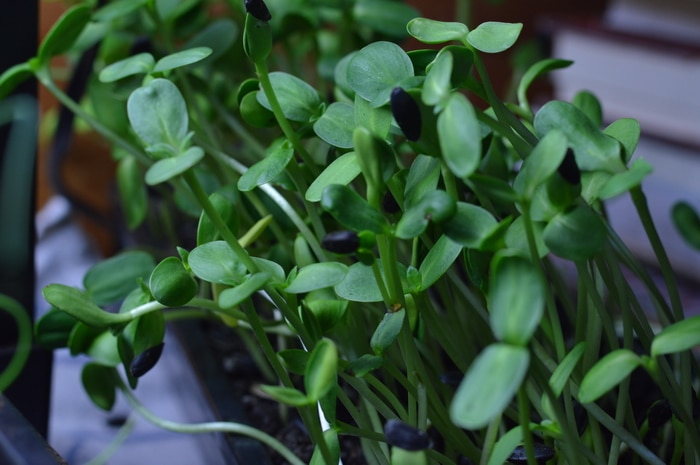
Sunflower sprouts taste fresh, with a mild flavor and just a hint of nuttiness at this time. The texture is smooth and juicy.
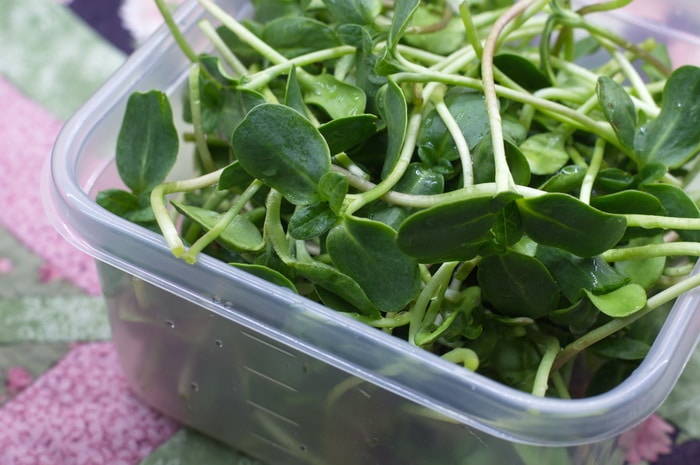
How to harvest sunflower microgreens
You’ll notice that your sunflower microgreens vary in the stage of development they are in. Some sprouts will have the true leaves beginning to form, while other sprouts are still bent over and firmly holding on to their seed casing.
Try to avoid cutting the more immature sunflower greens while you harvest the ones that are tall and showing signs of their first true leaves. If you are careful you may get a second harvest in a couple of days from the pot.
Each sunflower microgreen can only be harvested once. They will not regrow from the same stock. So by leaving the immature sunflower sprouts a little longer, and only harvesting the sprout that are prime, you’ll prolong your harvest window.
How to use sunflower sprouts and sunflower microgreens
Sunflower microgreens can be served fresh as a salad in the place of lettuce. Serve with a squeeze of lemon juice and a drizzle of extra virgin olive oil to allow the flavor to show through. Sunflower sprouts and microgreens can also be cooked. Add it to the dish at the end of the cooking period, after you take the pot off the heat. This way the sunflower microgreens retain their crisp texture and fresh taste while enhancing dishes like rice or mashed potatoes.
Fold sunflower sprouts into a cheese omelet just before serving. The heat of the omelet will wilt the sunflower sprouts without making them soggy.
Serve sprouts as a sandwich topper just as you would use alfalfa sprouts or baby lettuce.

What to do with the planting pot after the microgreens are harvested?
The soil that is left after the sunflower microgreens are harvested can be used again with fresh sunflower seed. Follow steps 1 and 2 above, but when you are ready to plant your sprouts on day 4, simply place them on the soil surface of your pot and cover loosely with a fresh layer of potting mix.
The previous layer of sprouts will die back and feed the new layer of sprouts. You should be able to get 3 crops of sunflower sprouts from one pot before you need to refresh the soil.
Damping off fungal disease and your microgreens
If at any time the pot you are using develops damping off disease, a fungus that affects seedlings grown indoors with poor air circulation, sprinkle the soil surface with cinnamon and only water the pot from below. Try to increase the air circulation around the pots by adding a fan close to the growing area. Throw away any microgreens that are affected by damping off disease.
Damping off can be prevented by washing and sanitizing pots before planting and using cinnamon powder or cayenne powder on the soil surface when planting.
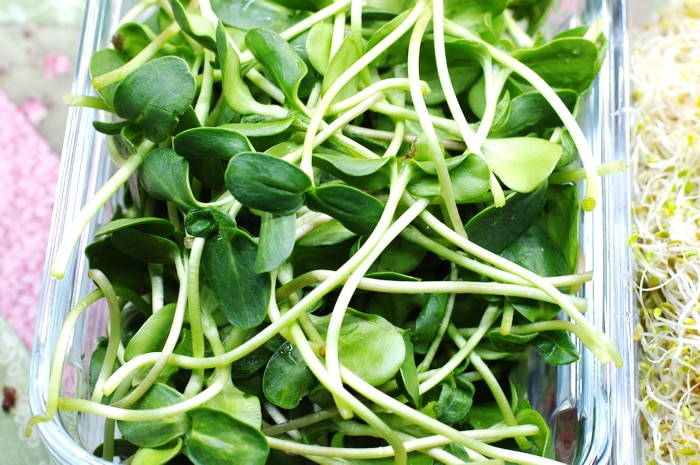
These grow so fast you can share them
Sunflower microgreens and sprouts are an easy to grow and underutilized salad green that is fun to grow at home. You can grow a crop from seed to harvest in as little as 7 to 10 days. There is no need to add additional soil amendments when growing microgreens. The nutrients required by the sprout are already resident in the seed itself.
Try growing sprouts and sunflower microgreens for nutritious and tasty greens in less than two weeks, while you wait for your garden to grow.
More ways to use sunflowers from Joybilee Farm
How to Prepare Sunflower Buds Like Artichokes
10 Types of Sunflowers to Grow for a Picture Perfect Garden
How to Grow Giant Sunflowers For Competition and Beauty
Sunflower sprouts and microgreens are just the beginning
Check out the Fill Your Salad Bowl workshop and learn how to use 3 different growing methods, at home, so you can fill your salad bowl with super food, nutrient dense, greens every single day. These are greens, including sunflower sprouts, you can use in your salad bowl, greens you can add to soups, stews, and pasta dishes, and even greens you can use in a stir fry.
In this mini workshop you will learn how to fill a salad bowl every day with food you grow yourself in your kitchen.
- Even if you don’t have any land.
- Even if there is 3 feet of snow covering your garden
- Even if you’ve killed house plants in the past.
- Even if you think you have a black thumb.
Have a look at what’s covered in this workshop and see if its a good fit for you, by clicking/tapping the blue button below.








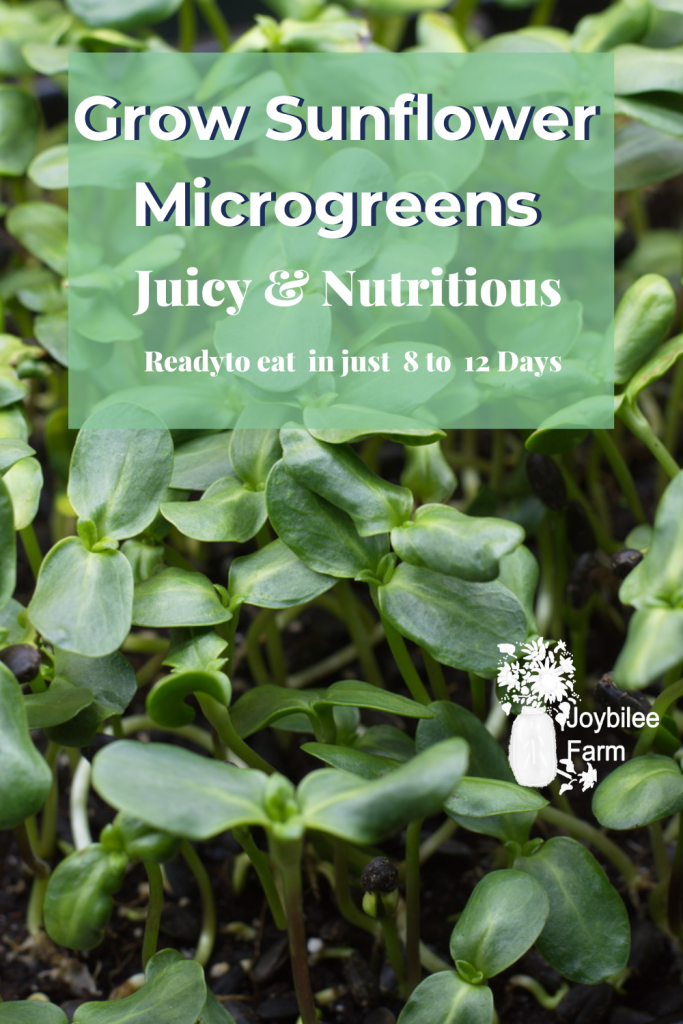
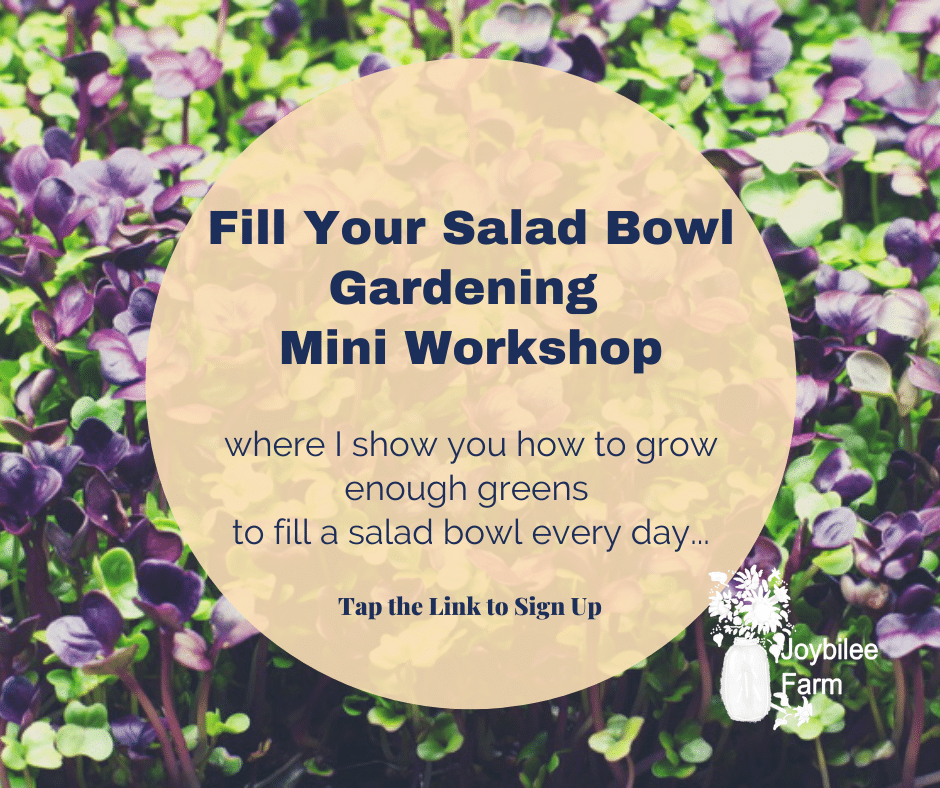


I am interested in the trays you are using. I would love to make this process easier for myself .. thanks
Thanks for sharing, this is very informative, I am trying my first batch. Blessing Benjamin.
It could be the seed itself. Are you using sunflower microgreen seed? How old is it? What kind of sunflower seed? In 2020 there was a black oil seed crop failure and a lot of the sunflower seed being sold as microgreen seed has poor germination or slow germination this year. You might try giving it a weight on top during the germination to see if it improves for you. (The weight mimics soil)